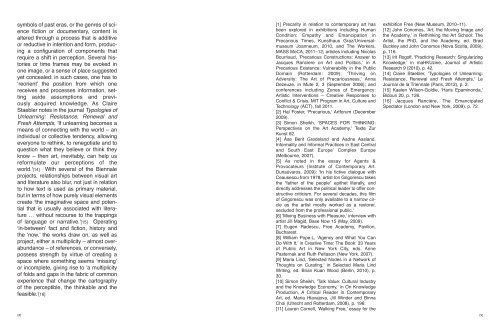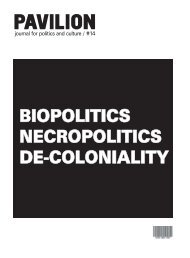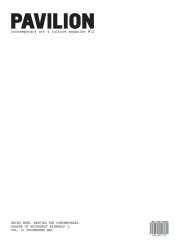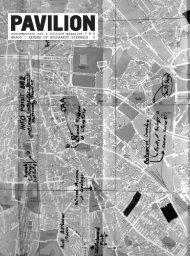Download pdf version of issue no. 16 (4 Mb) - Pavilion
Download pdf version of issue no. 16 (4 Mb) - Pavilion
Download pdf version of issue no. 16 (4 Mb) - Pavilion
You also want an ePaper? Increase the reach of your titles
YUMPU automatically turns print PDFs into web optimized ePapers that Google loves.
symbols <strong>of</strong> past eras, or the genres <strong>of</strong> science<br />
fiction or documentary, content is<br />
altered through a process that is additive<br />
or reductive in intention and form, producing<br />
a configuration <strong>of</strong> components that<br />
require a shift in perception. Several histories<br />
or time frames may be evoked in<br />
one image, or a sense <strong>of</strong> place suggested<br />
yet concealed: in such cases, one has to<br />
‘reorient’ the position from which one<br />
receives and processes information, setting<br />
aside assumptions and previously<br />
acquired k<strong>no</strong>wledge. As Claire<br />
Staebler <strong>no</strong>tes in the journal Typologies <strong>of</strong><br />
Unlearning: Resistance, Renewal and<br />
Fresh Attempts, 'If unlearning becomes a<br />
means <strong>of</strong> connecting with the world – an<br />
individual or collective tendency, allowing<br />
everyone to rethink, to renegotiate and to<br />
question what they believe or think they<br />
k<strong>no</strong>w – then art, inevitably, can help us<br />
reformulate our perceptions <strong>of</strong> the<br />
world.'[14] With several <strong>of</strong> the Biennale<br />
projects, relationships between visual art<br />
and literature also blur, <strong>no</strong>t just in relation<br />
to how text is used as primary material,<br />
but in terms <strong>of</strong> how purely visual elements<br />
create 'the imaginative space and potential<br />
that is usually associated with literature<br />
… without recourse to the trappings<br />
<strong>of</strong> language or narrative.'[15] Operating<br />
‘in-between’ fact and fiction, history and<br />
the ‘<strong>no</strong>w,’ the works draw on, as well as<br />
project, either a multiplicity – almost overabundance<br />
– <strong>of</strong> references, or conversely,<br />
possess strength by virtue <strong>of</strong> creating a<br />
space where something seems ‘missing’<br />
or incomplete, giving rise to 'a multiplicity<br />
<strong>of</strong> folds and gaps in the fabric <strong>of</strong> common<br />
experience that change the cartography<br />
<strong>of</strong> the perceptible, the thinkable and the<br />
feasible.'[<strong>16</strong>]<br />
[8]<br />
[1] Precarity in relation to contemporary art has<br />
been explored in exhibitions including Human<br />
Condition: Empathy and Emancipation in<br />
Precarious Times, Kunsthaus Graz/Universalmuseum<br />
Joanneum, 2010, and The Workers,<br />
MASS MoCA, 2011–12; articles including Nicolas<br />
Bourriaud, 'Precarious Constructions: Answer to<br />
Jacques Ranciere on Art and Politics,' in A<br />
Precarious Existence: Vulnerability in the Public<br />
Domain (Rotterdam: 2009); 'Thriving on<br />
Adversity: The Art <strong>of</strong> Precariousness,' Anna<br />
Dezeuze, in Mute 2, 3 (September 2006); and<br />
conferences including Zones <strong>of</strong> Emergency:<br />
Artistic Interventions – Creative Responses to<br />
Conflict & Crisis, MIT Program in Art, Culture and<br />
Tech<strong>no</strong>logy (ACT), fall 2011.<br />
[2] Hal Foster, 'Precarious,' Artforum (December<br />
2009).<br />
[3] Simon Sheikh, 'SPACES FOR THINKING:<br />
Perspectives on the Art Academy,' Texte Zur<br />
Kunst 62.<br />
[4] Åse Berit Grødeland and Aadne Aasland,<br />
Informality and Informal Practices in East Central<br />
and South East Europe’ Complex Europe<br />
(Melbourne, 2007).<br />
[5] As <strong>no</strong>ted in the essay for Agents &<br />
Provocateurs (Institute <strong>of</strong> Contemporary Art.<br />
Dunaúvaros, 2009): 'In his fictive dialogue with<br />
Ceausescu from 1978, artist Ion Grigorescu takes<br />
the “father <strong>of</strong> the people” epithet literally, and<br />
directly addresses the political leader to <strong>of</strong>fer constructive<br />
criticism. For several decades, this film<br />
<strong>of</strong> Grigorescu was only available to a narrow circle<br />
as the artist mostly worked as a restorer,<br />
secluded from the pr<strong>of</strong>essional public.'<br />
[6] 'Mixing Business with Pleasure,' interview with<br />
artist Jill Magid, Base Now 15 (May, 2009).<br />
[7] Eugen Radescu, Free Academy, <strong>Pavilion</strong>,<br />
Bucharest.<br />
[8] William Pope.L, 'Agency and What Y ou Can<br />
Do With It,' in Creative Time: The Book: 33 Years<br />
<strong>of</strong> Public Art in New York City, eds. Anne<br />
Pasternak and Ruth Peltason (New York, 2007).<br />
[9] Maria Lind, 'Selected Nodes in a Network <strong>of</strong><br />
Thoughts on Curating,' in Selected Maria Lind<br />
Writing, ed. Brian Kuan Wood (Berlin, 2010), p.<br />
30.<br />
[10] Simon Sheikh, 'Talk Value: Cultural Industry<br />
and the K<strong>no</strong>wledge Eco<strong>no</strong>my,' in On K<strong>no</strong>wledge<br />
Production, A Critical Reader in Contemporary<br />
Art, ed. Maria Hlavajova, Jill Winder and Binna<br />
Choi (Utrecht and Rotterdam, 2008), p. 196.<br />
[11] Lauren Cornell, 'Walking Free,' essay for the<br />
exhibition Free (New Museum, 2010–11).<br />
[12] John Co<strong>no</strong>mos, 'Art, the Moving Image and<br />
the Academy,' in Rethinking the Art School: The<br />
Artist, the PhD, and the Academy, ed. Brad<br />
Buckley and John Co<strong>no</strong>mos (Nova Scotia, 2009),<br />
p. 1<strong>16</strong>.<br />
[13] Irit Rog<strong>of</strong>f, 'Practicing Research: Singularizing<br />
K<strong>no</strong>wledge,' in maHKUzine, Journal <strong>of</strong> Artistic<br />
Research 9 (2010), p. 42.<br />
[14] Claire Staebler, 'Typologies <strong>of</strong> Unlearning:<br />
Resistance, Renewal and Fresh Attempts,' Le<br />
Journal de la Triennale (Paris, 2012), p. 2.<br />
[15] Kaelen Wilson-Goldie, 'Haris Epami<strong>no</strong>nda,'<br />
Bidoun 20, p. 126.<br />
[<strong>16</strong>] Jacques Rancière, The Emancipated<br />
Spectator (London and New York, 2009), p. 72.<br />
[9]








